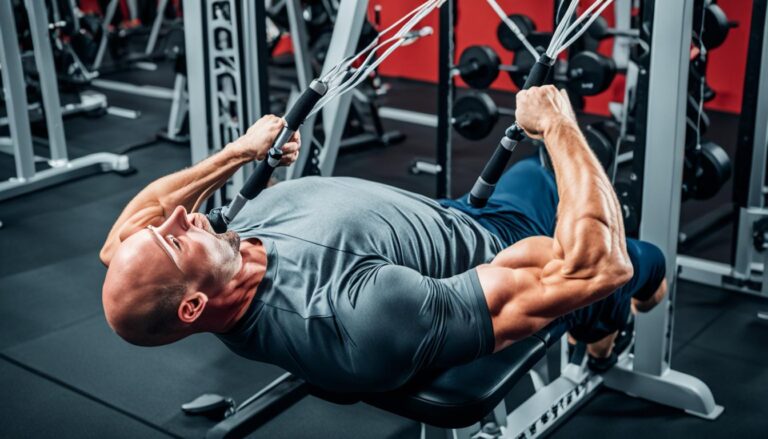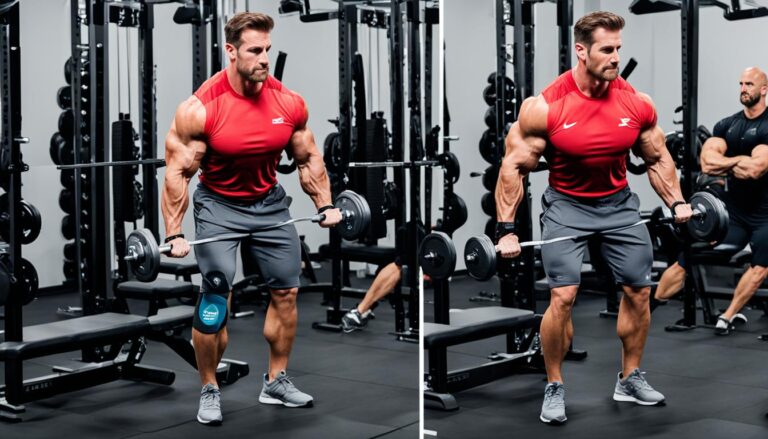In today’s fast-paced world, many fitness enthusiasts wonder if a 30 minute workout is sufficient to build muscle effectively. Shorter workout durations are highly appealing given time constraints, but do they truly promote muscle growth? Research from the American Council on Exercise and the Journal of Strength and Conditioning Research suggests that efficiency, not duration, is key to strength training success.
While the International Journal of Sports Nutrition and Exercise Metabolism emphasizes the importance of nutrition, our focus here is on the potential of a 30 minute workout to build muscle. This section will delve into the core elements that determine whether short yet intense exercise routines can lead to significant muscle development.
Key Takeaways
- A 30 minute workout can be enough to stimulate muscle growth with the right intensity.
- Efficiency in strength training is crucial for effective muscle building.
- The quality of workouts often surpasses the importance of their duration.
- Shorter workouts can fit more easily into busy schedules, ensuring consistency.
- Proper technique and exercise selection are vital in maximizing muscle development within a short timeframe.
The Basics of Muscle Growth
Understanding muscle growth is fundamental to optimizing your fitness routine. The process, known as muscle hypertrophy, is driven by various physiological factors and training principles that anyone serious about muscle building should comprehend.
Muscle Hypertrophy Explained
Muscle hypertrophy refers to the increase in the size of muscle cells, primarily achieved through consistent resistance training. The process involves the dual mechanisms of mechanical tension and metabolic stress that stimulate anabolic reactions. These reactions promote protein synthesis, rebuilding muscle fibers stronger and larger than before.
Key Factors in Muscle Building
Several key factors influence the efficiency of muscle growth:
- Genetic Predisposition: Individual genetic makeup significantly impacts how one’s muscles respond to training stimuli.
- Age: As we age, the rate of muscle growth can slow down due to hormonal changes and a natural decline in protein synthesis rates.
- Hormonal Influences: Hormones such as testosterone and growth hormone play crucial roles in muscle hypertrophy by enhancing anabolic reactions and protein synthesis.
For a deeper exploration of the physiological processes and effective training approaches, consider reading more about the comparative benefits of working out at home versus at the.
The Importance of Workout Intensity
Workout intensity plays a crucial role in achieving muscle gain, particularly when time is a limiting factor. Understanding how intensity impacts your muscle-building efforts can guide you in structuring more effective workouts. The relationship between intensity and exercise duration is often misunderstood, but balancing these elements can lead to optimal results.
How Intensity Affects Muscle Gain
High workout intensity triggers muscle hypertrophy, the process where muscle fibers grow in size. According to the Journal of Physiology, intense exercises increase the recruitment of muscle fibers, which is essential for muscle gain. Higher intensity workouts also activate more muscle groups, leading to a well-rounded development. Utilizing both cable machines and free weights can enhance your workout intensity, offering a comprehensive approach to strength training.
Balancing Intensity and Duration
One of the critical challenges is finding the right balance between workout intensity and exercise duration. As per Medicine and Science in Sports and Exercise, maintaining high intensity during shorter workouts can be just as effective as longer sessions. Effective workouts often encompass high-intensity techniques such as supersets or high-intensity interval training (HIIT), allowing individuals to maximize their muscle gain within a limited timeframe.
Reviewing your fitness goals and adjusting your workout intensity accordingly can help in striking the right balance. For instance, consider the differences between cable workouts and free weights to determine the most suitable method for your routine.
| Intensity Level | Exercise Technique | Benefits |
|---|---|---|
| High | HIIT, Supersets | Maximized muscle gain, improved cardiovascular health |
| Moderate | Traditional sets, circuit training | Gradual muscle growth, balanced fitness |
| Low | Steady-state cardio, light weights | Endurance building, joint health |
The European Journal of Applied Physiology supports the idea that varying workout intensity can prevent plateaus, ensuring continuous progress in muscle gain. Balancing intensity and exercise duration is not only about achieving immediate results but also about sustaining long-term effectiveness.
Optimizing a 30 Minute Fitness Routine
Creating an effective 30-minute fitness routine requires a focus on efficient workouts to maximize every second. By integrating compound exercises and a well-planned training regimen, you can achieve significant muscle growth even in a limited timeframe.
Structuring Your Workouts for Efficiency
To get the most out of your compact workouts, it’s essential to structure them effectively. Start with a brief warm-up to get your muscles ready. Follow up with a balanced mix of exercises focusing on different muscle groups. This approach ensures that your fitness routine remains comprehensive despite the time constraint.
Here’s how you can break down your 30-minute training regimen:
- Warm-up (5 minutes)
- Main workout (20 minutes)
- Cool-down and stretching (5 minutes)
This structure helps maintain the intensity and effectiveness of your sessions.
Choosing the Right Exercises
When time is limited, selecting the right exercises is crucial. Compound exercises are particularly beneficial as they engage multiple muscle groups simultaneously, making your workouts more efficient. Examples of compound exercises include squats, deadlifts, bench presses, and pull-ups.
Incorporating these exercises into your training regimen ensures that you make the most out of each session by targeting several muscles at once, thereby fostering quicker muscle growth.
Here’s a quick example of a balanced routine:
- Squats
- Deadlifts
- Bench Presses
- Pull-Ups
By adhering to these principles, you can design a fitness routine that is both time-efficient and effective, promoting steady muscle growth and overall fitness improvement.
Strength Training Techniques for Quick Workouts
When time is limited, effective strength training techniques become essential for maximizing muscle gains. Incorporating methods such as High-Intensity Interval Training (HIIT), supersets, and circuit training can generate significant improvements in muscle strength and endurance. Here, I explore the benefits and methodologies of each approach.
High-Intensity Interval Training (HIIT)
High-Intensity Interval Training (HIIT) is a powerful way to integrate cardio and strength training into a compact workout. According to studies from The Journal of Strength & Conditioning Research, HIIT can enhance both aerobic and anaerobic fitness, encouraging muscle growth and fat loss simultaneously. By alternating between short bursts of intense activity and brief periods of rest or low-intensity exercise, HIIT keeps the heart rate elevated, ensuring efficient calorie burning and muscle stimulation.

Supersets and Circuit Training
Supersets and circuit training are two dynamic methods that elevate the intensity of workouts. Supersets involve performing two exercises back-to-back without rest, typically targeting opposing muscle groups. This approach not only saves time but also maintains muscle engagement and improves recovery rates. As highlighted by research in Medicine & Science in Sports & Exercise, supersets can significantly enhance muscle hypertrophy and strength.
Circuit training, on the other hand, consists of performing a series of exercises in succession with minimal rest between each. It blends aerobic conditioning with strength training, promoting cardiovascular health along with muscle endurance. The European Journal of Applied Physiology notes that circuit training is particularly effective for burning calories and enhancing overall fitness. This technique ensures that no time is wasted, making it ideal for a 30-minute workout.
Incorporating these strength training techniques into your routine can maximize the productivity of short workouts, helping you achieve muscle growth and overall fitness efficiently.
Is a 30 Minute Workout Enough to Build Muscle?
The debate surrounding the effectiveness of 30-minute workouts for muscle development continues to engage the fitness community. Recent studies published in the International Journal of Exercise Science have shown that brief, high-intensity sessions can lead to significant gains in muscle hypertrophy. However, the key lies in optimizing exercise duration and incorporating effective strength-training techniques.
Experts from the Journal of Sports Science & Medicine emphasize that quick workouts, when done consistently, can positively impact muscle growth. The science suggests that even 30 minutes of focused, intense training can stimulate muscle fibers sufficiently to promote development. By focusing on peak contraction and utilizing compound movements, individuals can ensure they are making the most out of shorter workouts.
Furthermore, a well-structured quick workout regimen within this time frame can foster an environment conducive to bodybuilding. The use of cable machines, for example, ensures constant tension on the muscles, which is crucial for achieving balanced muscle development. More on this can be found in this article that discusses using cables for building arm strength and muscle definition.
Importantly, the American College of Sports Medicine (ACSM) guidelines recommend varying the types of exercises and intensity levels to avoid plateaus and to continuously challenge the muscles. Below is a comparative look at different strength-training protocols and their efficiency within a restricted exercise duration:
| Training Protocol | Duration | Effectiveness in Muscle Building |
|---|---|---|
| High-Intensity Interval Training (HIIT) | 30 minutes | High |
| Supersets | 30 minutes | Moderate |
| Traditional Strength Training | 60 minutes | Very High |
The Role of Consistency in Muscle Growth
Consistency in training plays a critical role in achieving sustained muscle growth. By adhering to a regular exercise schedule, you enable your body to undergo necessary muscle adaptation, which is essential for continued development and strength gains.
Importance of Regular Exercise
Engaging in regular exercise ensures that your muscles consistently receive stimuli, prompting them to grow and adapt over time. Without a steady workout regimen, muscle adaptation cannot occur effectively, leading to stagnation. Scientific studies, such as those published in The Journal of Physiology and PLoS ONE, highlight the importance of regular physical activity for maintaining and enhancing muscle mass.
- Steady Progress: Regular exercise promotes continuous improvement rather than sporadic gains.
- Preventing Regression: Consistency helps in preventing the loss of muscle strength over periods of inactivity.
Avoiding Plateaus in Your Training
Workout plateaus can be frustrating, as they signal a halt in progress. These occur when muscles have fully adapted to the current exercise regimen. To prevent such stagnation, it’s vital to vary your workouts and introduce new challenges, ensuring ongoing muscle adaptation.
| Strategy | Benefit |
|---|---|
| Incorporate Change | Introduce new exercises to keep muscles engaged and continuously adapting. |
| Adjust Intensity | Modify workout intensity to prevent muscles from becoming accustomed to a routine. |
| Track Progress | Keep a workout log to identify stagnation points and adjust accordingly. |
In conclusion, maintaining consistency in training and engaging in regular exercise are vital for sustained muscle growth. By strategically avoiding workout plateaus, you can ensure that your muscles continue to adapt, grow, and strengthen over time.
Adjusting Workout Frequency for Better Results
Adjusting workout frequency can significantly impact your overall fitness journey. Finding the right balance between active and rest days is crucial for effective muscle growth and recovery. Let’s delve into how to optimize your training frequency to achieve better results.
Balancing Rest and Workout Days
One of the key considerations in any fitness regime is the balance between workout days and recovery time. Engaging in back-to-back intense workouts without proper recovery can lead to fatigue and potential injury. Conversely, too much rest can hinder progress.
According to findings published in Sports Medicine, an optimal workout schedule typically includes 3-4 sessions per week focusing on different muscle groups. This allows sufficient recovery time for each muscle group to heal and grow stronger.
Frequency vs. Duration: What Matters More?
When it comes to advancing your fitness goals, the debate of frequency versus duration is ongoing. However, research from Clinical Physiology and Functional Imaging suggests that training frequency might be slightly more impactful than duration, especially for muscle hypertrophy.
Meeting your optimal workout schedule does not necessarily imply longer workouts. Instead, focus on consistent, quality sessions with appropriate intensity. A well-structured 30-minute workout can be as effective as a longer one if integrated correctly within your overall training frequency.
To offer a clearer comparison of how workout frequency and duration impact muscle growth, review the table below:
| Parameter | High Frequency (5-6 days) | Moderate Frequency (3-4 days) | Low Frequency (1-2 days) |
|---|---|---|---|
| Muscle Recovery | Shorter recovery time needed | Moderate recovery required | Extended recovery time |
| Muscle Growth | Optimal with sufficient recovery | Very effective | Less effective |
| Injury Risk | Higher if overtraining | Balanced | Lower |
By strategically adjusting your workout frequency and ensuring adequate recovery time, you can achieve a well-rounded and effective fitness routine. Notably, it’s essential to listen to your body and adapt your training schedule to match your individual needs and capabilities.
Nutrition’s Impact on Muscle Gain
Achieving significant muscle gain is not only about consistent workouts and high intensity but also deeply rooted in proper workout nutrition. Ensuring your body gets the right macronutrient intake, including carbohydrates, fats, and proteins, is essential for effective muscle repair and growth.
Nutrients play a crucial role in muscle recovery. Right after exercise, your muscles need adequate amounts of protein to initiate the repair process. Fulfilling your body’s dietary requirements for protein can be achieved through foods like chicken, fish, lean beef, and legumes, among others.
According to the Journal of the International Society of Sports Nutrition, consuming a mix of carbohydrates and proteins post-workout helps replenish glycogen stores and foster muscle adaptation. The combination ensures that the right nutrients are available when needed the most.
To streamline your nutritional intake, it’s helpful to be aware of the key dietary components required for muscle gain. Here is a concise overview:
| Macronutrient | Role | Sources |
|---|---|---|
| Protein | Muscle repair & growth | Lean meats, beans, dairy |
| Carbohydrates | Energy replenishment | Whole grains, fruits, vegetables |
| Fats | Hormonal function | Avocados, nuts, olive oil |
Meeting your dietary requirements isn’t always straightforward, but planning your workout nutrition can optimize your gains. By incorporating balanced meals rich in macronutrients and timing them effectively, you’ll enhance muscle growth significantly.
Common Mistakes to Avoid in Short Workouts
Short workout sessions can be incredibly effective, but only when executed correctly. One of the most common workout mistakes I see is individuals either overtraining or undertraining. Both extremes can be detrimental to muscle growth and overall fitness. Understanding the right balance is crucial for anyone looking to make the most out of their brief exercise routines.
Overtraining and Undertraining
Overtraining occurs when you push your body beyond its limits without giving it adequate time to recover. This can lead to burnout, injury, and decreased performance. On the other hand, undertraining means not challenging your muscles enough, preventing you from making significant gains. The key lies in striking a balance: aim for a high-intensity effort that’s sustainable and allows for recovery. According to the Journal of Athletic Training, it’s essential to listen to your body and adjust your intensity and volume accordingly.
Neglecting Proper Form
Another fundamental error is neglecting proper workout form. Poor form not only reduces the effectiveness of your exercises but also increases the risk of injury. For instance, when targeting your back muscles, using a cable machine can help maintain constant tension. Proper form and posture tips are vital to maximize safety and workout effectiveness. For additional insights, check out this comprehensive guide on building a stronger back through cable.
By being mindful of these common workout mistakes, you can optimize your short workout sessions for better results. Adjust your training load to find the right balance and always prioritize proper form to avoid injuries and maximize muscle growth. The knowledge derived from sources like BMC Sports Science, Medicine, and Rehabilitation and The Physician and Sportsmedicine supports these best practices, enabling you to achieve your fitness goals efficiently.
FAQ
Is a 30 minute workout enough to build muscle?
Yes, a 30 minute workout can be enough to build muscle if it is structured correctly and incorporates high-intensity strength training. According to the American Council on Exercise, focusing on efficiency and intensity during these shorter sessions can effectively stimulate muscle growth. Research from the Journal of Strength and Conditioning Research and the International Journal of Sports Nutrition and Exercise Metabolism supports this by highlighting that the quality of the workout is more crucial than its duration.
What is muscle hypertrophy?
Muscle hypertrophy refers to the growth and increase in the size of muscle cells. It is primarily achieved through resistance training, which induces stress on the muscles, leading to micro-tears that are repaired through anabolic reactions and protein synthesis. Factors such as genetic predisposition, age, and hormonal influences also play significant roles in muscle hypertrophy, as discussed in the Sports Medicine and Physiology & Behavior journals.
How does workout intensity affect muscle gain?
Workout intensity is a critical factor in muscle gain because it determines the workload on your muscles. High-intensity workouts lead to greater muscle fatigue and micro-tears, which are essential for growth. The Journal of Physiology and Medicine and Science in Sports and Exercise emphasize that maintaining a high level of intensity, even in shorter workouts, can maximize muscle hypertrophy.
How can I structure my workouts for efficiency?
To structure your workouts efficiently, focus on compound exercises that work multiple muscle groups simultaneously. This approach ensures that you make the most out of your 30-minute session. Resources like the Journal of Applied Physiology and Clinical Biomechanics suggest incorporating exercises such as squats, deadlifts, and bench presses for a comprehensive workout regimen.
What are High-Intensity Interval Training (HIIT) and supersets?
High-Intensity Interval Training (HIIT) involves short bursts of intense exercise followed by brief recovery periods, making it an excellent method for building muscle in a short time. Supersets involve performing two exercises back-to-back with minimal rest, targeting different muscle groups. Both techniques are effective for quick, intense workouts, supported by findings from The Journal of Strength & Conditioning Research and Medicine & Science in Sports & Exercise.
Why is consistency important in muscle growth?
Consistency is crucial in muscle growth because regular exercise promotes continuous muscle adaptation and prevents plateaus. The Journal of Physiology and PLoS ONE highlight that consistent training routines ensure progressive overload, a key factor in muscle hypertrophy. Avoiding extended breaks and maintaining a steady workout schedule are essential for sustained muscle development.
How should I balance rest and workout days?
Balancing rest and workout days involves ensuring adequate recovery time for your muscles to repair and grow. Training every muscle group 2-3 times per week with at least one rest day in between is often recommended. Studies from Sports Medicine and Clinical Physiology and Functional Imaging indicate that both workout frequency and proper recovery are vital for optimal muscle growth and performance.
How does nutrition impact muscle gain?
Nutrition plays a pivotal role in muscle gain by providing the necessary nutrients for muscle repair and growth. Consuming the right balance of calories, proteins, carbohydrates, and fats is essential for effective muscle hypertrophy. Journals like the Journal of the International Society of Sports Nutrition and The American Journal of Clinical Nutrition stress the importance of macronutrient intake and proper meal timing to support muscle-building efforts.
What are common mistakes to avoid in short workouts?
Common mistakes in short workouts include overtraining, undertraining, and neglecting proper form. Overtraining can lead to injuries and burnout, while undertraining may not provide enough stimulus for muscle growth. Additionally, improper form can reduce the effectiveness of exercises and increase the risk of injury. Journals such as the Journal of Athletic Training and BMC Sports Science, Medicine, and Rehabilitation offer insights on how to avoid these pitfalls.







